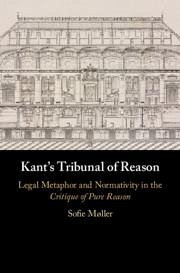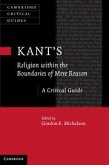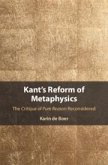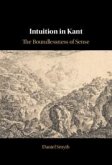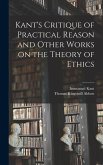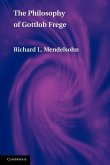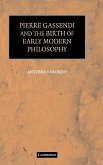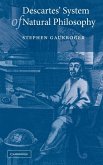- Gebundenes Buch
- Merkliste
- Auf die Merkliste
- Bewerten Bewerten
- Teilen
- Produkt teilen
- Produkterinnerung
- Produkterinnerung
This is the first book-length study in English of Kant's legal metaphors, whose philosophical importance has so far been overlooked.
Andere Kunden interessierten sich auch für
![Kant's Religion Within the Boundaries of Mere Reason Kant's Religion Within the Boundaries of Mere Reason]() Kant's Religion Within the Boundaries of Mere Reason132,99 €
Kant's Religion Within the Boundaries of Mere Reason132,99 €![Kant's Reform of Metaphysics Kant's Reform of Metaphysics]() Karin De BoerKant's Reform of Metaphysics111,99 €
Karin De BoerKant's Reform of Metaphysics111,99 €![Intuition in Kant Intuition in Kant]() Daniel SmythIntuition in Kant118,99 €
Daniel SmythIntuition in Kant118,99 €![Kant's Critique of Practical Reason and Other Works on the Theory of Ethics Kant's Critique of Practical Reason and Other Works on the Theory of Ethics]() Immanuel KantKant's Critique of Practical Reason and Other Works on the Theory of Ethics45,99 €
Immanuel KantKant's Critique of Practical Reason and Other Works on the Theory of Ethics45,99 €![The Philosophy of Gottlob Frege The Philosophy of Gottlob Frege]() Richard L. MendelsohnThe Philosophy of Gottlob Frege51,99 €
Richard L. MendelsohnThe Philosophy of Gottlob Frege51,99 €![Pierre Gassendi and the Birth of Early Modern Philosophy Pierre Gassendi and the Birth of Early Modern Philosophy]() Antonia LolordoPierre Gassendi and the Birth of Early Modern Philosophy107,99 €
Antonia LolordoPierre Gassendi and the Birth of Early Modern Philosophy107,99 €![Descartes' System of Natural Philosophy Descartes' System of Natural Philosophy]() Stephen GaukrogerDescartes' System of Natural Philosophy108,99 €
Stephen GaukrogerDescartes' System of Natural Philosophy108,99 €-
-
-
This is the first book-length study in English of Kant's legal metaphors, whose philosophical importance has so far been overlooked.
Hinweis: Dieser Artikel kann nur an eine deutsche Lieferadresse ausgeliefert werden.
Hinweis: Dieser Artikel kann nur an eine deutsche Lieferadresse ausgeliefert werden.
Produktdetails
- Produktdetails
- Verlag: Cambridge University Press
- Seitenzahl: 208
- Erscheinungstermin: 16. April 2020
- Englisch
- Abmessung: 231mm x 165mm x 13mm
- Gewicht: 363g
- ISBN-13: 9781108498494
- ISBN-10: 1108498493
- Artikelnr.: 58024775
- Herstellerkennzeichnung
- Libri GmbH
- Europaallee 1
- 36244 Bad Hersfeld
- gpsr@libri.de
- Verlag: Cambridge University Press
- Seitenzahl: 208
- Erscheinungstermin: 16. April 2020
- Englisch
- Abmessung: 231mm x 165mm x 13mm
- Gewicht: 363g
- ISBN-13: 9781108498494
- ISBN-10: 1108498493
- Artikelnr.: 58024775
- Herstellerkennzeichnung
- Libri GmbH
- Europaallee 1
- 36244 Bad Hersfeld
- gpsr@libri.de
Sofie Møller is a research associate in philosophy at Goethe-Universität Frankfurt Am Main.
Introduction
I.1 The cognitive function of metaphors
I.2 Methodological considerations
I.3 The primacy of practical reason and epistemic normativity
I.4 Outline of the book
1. The critique as the establishment of reason's lawful condition
1.1 The critique as a review of laws
1.2 The natural right tradition and the Naturrecht Feyerabend
1.3 The critique as a lawful solution to conflicts
1.4 Establishing a rightful condition
2. The normativity of law
2.1 Natural right and positive law
2.2 Laws of nature in the natural sciences
2.3 A priori laws as objectively valid rules
2.4 Laws and principles
2.5 The understanding as prescribing laws to nature
3. The transcendental deduction and the tradition of legal deductions
3.1 Quid juris and the transcendental deduction
3.2 The analogy between concepts and property
3.3 The transcendental deduction as a legal deduction tracing an origin
3.4 The tradition of legal deductions
4. The question of fact and the question of law in judicial imputation and in the transcendental deduction
4.1 Quid facti and the tracing of an origin
4.2 Quid facti and the metaphysical deduction
4.3 The question of fact and the question of law in judicial imputation
4.4 The transcendental deduction as judicial imputation
5. The tribunal of reason
5.1 The critique as tribunal
5.2 The Antinomies as a legal trial
5.3 Empirical experience as testimony
5.4 The reader as judge of the critique
5.5 The outcome of the critique as verdict
6. Moral conscience as the practical inner tribunal
6.1 Conscience as an inner tribunal
6.2 Self-deception in moral conscience
6.3 The problem of an erring conscience
6.4 Parallels between moral conscience and the critique of pure reason
7. Distinguishing between rightful claims and groundless pretensions
7.1 Historical background on judicial authority
7.2 Kant on judicial authority
7.3 The judicial office in the legal metaphors
7.4 Authority and validity of judgments and inferences
8. Epistemic authority as both individual and collectively shared
8.1 Decrees as the opposite of verdicts
8.2 Cognitive attitudes
8.3 Epistemic authority and the thinking self
8.4 Political aspects of the critique of pure reason
8.5 The community of cognisers
9. Systematicity and philosophy as the legislation of reason
9.1 Other images of systematicity: the organism and the building
9.2 The legal metaphors as illustrations of systematicity
9.3 Philosophy as the legislation of human reason
9.4 Systematicity in the Appendix to the Transcendental Dialectic
9.5 The critique as the science of the laws of pure reason
Conclusion.
I.1 The cognitive function of metaphors
I.2 Methodological considerations
I.3 The primacy of practical reason and epistemic normativity
I.4 Outline of the book
1. The critique as the establishment of reason's lawful condition
1.1 The critique as a review of laws
1.2 The natural right tradition and the Naturrecht Feyerabend
1.3 The critique as a lawful solution to conflicts
1.4 Establishing a rightful condition
2. The normativity of law
2.1 Natural right and positive law
2.2 Laws of nature in the natural sciences
2.3 A priori laws as objectively valid rules
2.4 Laws and principles
2.5 The understanding as prescribing laws to nature
3. The transcendental deduction and the tradition of legal deductions
3.1 Quid juris and the transcendental deduction
3.2 The analogy between concepts and property
3.3 The transcendental deduction as a legal deduction tracing an origin
3.4 The tradition of legal deductions
4. The question of fact and the question of law in judicial imputation and in the transcendental deduction
4.1 Quid facti and the tracing of an origin
4.2 Quid facti and the metaphysical deduction
4.3 The question of fact and the question of law in judicial imputation
4.4 The transcendental deduction as judicial imputation
5. The tribunal of reason
5.1 The critique as tribunal
5.2 The Antinomies as a legal trial
5.3 Empirical experience as testimony
5.4 The reader as judge of the critique
5.5 The outcome of the critique as verdict
6. Moral conscience as the practical inner tribunal
6.1 Conscience as an inner tribunal
6.2 Self-deception in moral conscience
6.3 The problem of an erring conscience
6.4 Parallels between moral conscience and the critique of pure reason
7. Distinguishing between rightful claims and groundless pretensions
7.1 Historical background on judicial authority
7.2 Kant on judicial authority
7.3 The judicial office in the legal metaphors
7.4 Authority and validity of judgments and inferences
8. Epistemic authority as both individual and collectively shared
8.1 Decrees as the opposite of verdicts
8.2 Cognitive attitudes
8.3 Epistemic authority and the thinking self
8.4 Political aspects of the critique of pure reason
8.5 The community of cognisers
9. Systematicity and philosophy as the legislation of reason
9.1 Other images of systematicity: the organism and the building
9.2 The legal metaphors as illustrations of systematicity
9.3 Philosophy as the legislation of human reason
9.4 Systematicity in the Appendix to the Transcendental Dialectic
9.5 The critique as the science of the laws of pure reason
Conclusion.
Introduction
I.1 The cognitive function of metaphors
I.2 Methodological considerations
I.3 The primacy of practical reason and epistemic normativity
I.4 Outline of the book
1. The critique as the establishment of reason's lawful condition
1.1 The critique as a review of laws
1.2 The natural right tradition and the Naturrecht Feyerabend
1.3 The critique as a lawful solution to conflicts
1.4 Establishing a rightful condition
2. The normativity of law
2.1 Natural right and positive law
2.2 Laws of nature in the natural sciences
2.3 A priori laws as objectively valid rules
2.4 Laws and principles
2.5 The understanding as prescribing laws to nature
3. The transcendental deduction and the tradition of legal deductions
3.1 Quid juris and the transcendental deduction
3.2 The analogy between concepts and property
3.3 The transcendental deduction as a legal deduction tracing an origin
3.4 The tradition of legal deductions
4. The question of fact and the question of law in judicial imputation and in the transcendental deduction
4.1 Quid facti and the tracing of an origin
4.2 Quid facti and the metaphysical deduction
4.3 The question of fact and the question of law in judicial imputation
4.4 The transcendental deduction as judicial imputation
5. The tribunal of reason
5.1 The critique as tribunal
5.2 The Antinomies as a legal trial
5.3 Empirical experience as testimony
5.4 The reader as judge of the critique
5.5 The outcome of the critique as verdict
6. Moral conscience as the practical inner tribunal
6.1 Conscience as an inner tribunal
6.2 Self-deception in moral conscience
6.3 The problem of an erring conscience
6.4 Parallels between moral conscience and the critique of pure reason
7. Distinguishing between rightful claims and groundless pretensions
7.1 Historical background on judicial authority
7.2 Kant on judicial authority
7.3 The judicial office in the legal metaphors
7.4 Authority and validity of judgments and inferences
8. Epistemic authority as both individual and collectively shared
8.1 Decrees as the opposite of verdicts
8.2 Cognitive attitudes
8.3 Epistemic authority and the thinking self
8.4 Political aspects of the critique of pure reason
8.5 The community of cognisers
9. Systematicity and philosophy as the legislation of reason
9.1 Other images of systematicity: the organism and the building
9.2 The legal metaphors as illustrations of systematicity
9.3 Philosophy as the legislation of human reason
9.4 Systematicity in the Appendix to the Transcendental Dialectic
9.5 The critique as the science of the laws of pure reason
Conclusion.
I.1 The cognitive function of metaphors
I.2 Methodological considerations
I.3 The primacy of practical reason and epistemic normativity
I.4 Outline of the book
1. The critique as the establishment of reason's lawful condition
1.1 The critique as a review of laws
1.2 The natural right tradition and the Naturrecht Feyerabend
1.3 The critique as a lawful solution to conflicts
1.4 Establishing a rightful condition
2. The normativity of law
2.1 Natural right and positive law
2.2 Laws of nature in the natural sciences
2.3 A priori laws as objectively valid rules
2.4 Laws and principles
2.5 The understanding as prescribing laws to nature
3. The transcendental deduction and the tradition of legal deductions
3.1 Quid juris and the transcendental deduction
3.2 The analogy between concepts and property
3.3 The transcendental deduction as a legal deduction tracing an origin
3.4 The tradition of legal deductions
4. The question of fact and the question of law in judicial imputation and in the transcendental deduction
4.1 Quid facti and the tracing of an origin
4.2 Quid facti and the metaphysical deduction
4.3 The question of fact and the question of law in judicial imputation
4.4 The transcendental deduction as judicial imputation
5. The tribunal of reason
5.1 The critique as tribunal
5.2 The Antinomies as a legal trial
5.3 Empirical experience as testimony
5.4 The reader as judge of the critique
5.5 The outcome of the critique as verdict
6. Moral conscience as the practical inner tribunal
6.1 Conscience as an inner tribunal
6.2 Self-deception in moral conscience
6.3 The problem of an erring conscience
6.4 Parallels between moral conscience and the critique of pure reason
7. Distinguishing between rightful claims and groundless pretensions
7.1 Historical background on judicial authority
7.2 Kant on judicial authority
7.3 The judicial office in the legal metaphors
7.4 Authority and validity of judgments and inferences
8. Epistemic authority as both individual and collectively shared
8.1 Decrees as the opposite of verdicts
8.2 Cognitive attitudes
8.3 Epistemic authority and the thinking self
8.4 Political aspects of the critique of pure reason
8.5 The community of cognisers
9. Systematicity and philosophy as the legislation of reason
9.1 Other images of systematicity: the organism and the building
9.2 The legal metaphors as illustrations of systematicity
9.3 Philosophy as the legislation of human reason
9.4 Systematicity in the Appendix to the Transcendental Dialectic
9.5 The critique as the science of the laws of pure reason
Conclusion.

